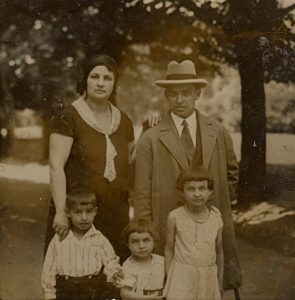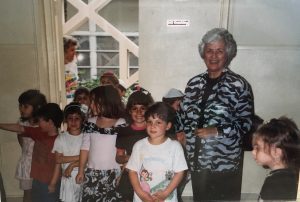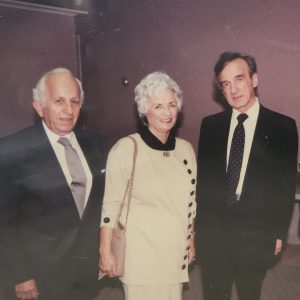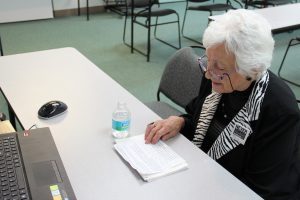Story #2 Mary Wygodski
 (Mary at age 4 with her family in Vilna, Poland)
(Mary at age 4 with her family in Vilna, Poland)
Mary’s life was uprooted in 1943 when she was separated from her mother, father, brother, and two younger sisters at the moment of their deportation from the Vilna ghetto. “They separated me from my family at this time and that was the greatest tragedy for me,” she said. Only later did she discover that her brother and father were taken to a concentration camp in Klooga, Estonia, where they were killed.
Mary was interned in three different labor camps during the war: first the Kaiserwald concentration camp near Riga, Latvia, then the Stutthof concentration camp, in what is now northern Poland, and finally the Magdeburg-Polte labor camp in Germany, where she was liberated by the U.S. Army on April 18, 1945.
Without her family, life seemed impossible. “I couldn’t be without my parents. I couldn’t live,” she recalls, “I said, I cannot go on like that.” She also lost faith in God. “I didn’t believe in God in the camps,” she said, “if he could do this to my family.” Shortly after arriving at Kaiserwald, she even attempted to drown herself in the nearby river, but she was saved by two men. As she came out of unconsciousness, she realized that she had had a vivid vision: “What I saw in the water was my whole family in front of me. And they pushed me back.” For a long time after the war, Mary would not discuss this saving vision for fear it would not be believed. But seeing her family that day gave her the strength to continue, with the hope that one day they would eventually be reunited. No one in her immediate family survived. But Mary has survived, she says, so that she can share her story and tell the world about the atrocities her family suffered.
After the war, Mary moved to Israel and faced the incomprehension of those who did not survive the ghettos and the camps. “In Israel when we first came, people couldn’t understand why we didn’t fight back, why we were going like sheep to the slaughter,” she said. “People couldn’t believe it, in Israel. So they didn’t like the Holocaust Survivors at first. But soon enough they found out that there was no way we could survive otherwise. That I survived was a miracle.”
After two years in Israel, Mary met her husband, who pursued her even though all his friends told him, Mary recalls, “not to date a Holocaust Survivor.” But although he was not a Holocaust Survivor, her future husband’s family were in Russia, and so he also had no family. They took each other in and were married in 1948.
A highly-acclaimed engineer, Mary’s husband was awarded a prestigious position in New York. Mary eventually joined him and they created their life in America. They both worked during the day, and Mary took classes at night. She was eventually certified as a kindergarten teacher. Once they moved to Florida, she worked for many years at the Pinellas County Jewish Day School.
 (Mary with her students)
(Mary with her students)
Mary has a son and a daughter, both of whom have taken great interest in continuing Mary’s legacy. Mary’s son lives in Tallahassee and is involved in Holocaust museum work there. Her daughter, Charlene, lives nearby and often joins her mother when she tells her story at The Florida Holocaust Museum and elsewhere.
The first time Mary told her story was to a relative with whom she was reunited in America after the war. “So when I came to the States for the first time, a cousin of mine sat down with me. He said I want you to tell me where you were and what you did. And I said no I can’t. I can’t, no, no, no. And of course, I started to cry. And he said, I’ll ask you questions. So he started with the questions and I told him the whole story. A whole night we were sitting and talking. A whole night and this was the first time that I opened up.”
Since then, she has been presented with many opportunities to share her story. It was difficult at first to speak about what she calls a passage through hell. But she soon became a confident, poised, and powerful speaker. It is important to Mary that she share her story so that all the deniers and unbelievers will know what happened.
 (Mary with her husband {left} and Elie Wiesel {right})
(Mary with her husband {left} and Elie Wiesel {right})
Unfortunately, she has experienced the necessity of telling her story first-hand. When traveling in Austria with her husband, she recalls walking by a crowd and overhearing people saying, “it never happened, it’s a lie.” She knew they were speaking about the Holocaust, and so she approached them and set the record straight.“It’s the truth. I was there,” she declared. The crowd fell silent, and then she was asked by a journalist in the group to please share her story with him. Mary agreed, and the next day the journalist and his crew took her to Mauthausen, where Mary told her story to the journalist and a group of school children. As she finished speaking, the journalist was in tears. Many years later, he contacted her again to tell her that her story was published in a textbook that is circulating in schools throughout Europe.
Mary sees the work of The Florida Holocaust Museum as crucial for the preservation of memory. She has been involved with the Museum since it first opened. She has spoken there on numerous occasions, published articles about the Museum, and even wrote a poem that was read when the boxcar housed in the Museum was first installed and dedicated. Indeed, for Mary, The Florida Holocaust Museum is “a second home.” It is a living memorial to her family.
 (Mary sharing her Holocaust Survivor story with students via Skype in 2016)
(Mary sharing her Holocaust Survivor story with students via Skype in 2016)
In an article she wrote to honor the 25th anniversary of The Florida Holocaust Museum, Mary writes:
“Our responsibility now is to make sure that the next generation and ones after will continue to treasure it like we do now. With each passing year the number of survivors decreases and when we are gone the importance of the museum increases. We know that evil is real in the world today. Our Museum and other Holocaust museums will be a reminder of what hatred and indifference or silence can do and most importantly a place for skeptics and deniers to learn the truth. We have an obligation and a pressing call of conscience to make it better for generations to come. Even though the evil of the Holocaust is singular, the lessons are universal. Now we are not and never will be silent again. It’s a privilege to fight for good against bad. Through education the Museum will ensure that those who perished, their memory, will endure forever. With joy and pride we will celebrate the twenty-fifth anniversary of this exceptional institution.”
Mary has had what she says are two beautiful lives – one before the war and one after the war. She is thankful for her family and the community she’s found at The Florida Holocaust Museum. She knows the importance of sharing her story, and, she says, she will keep speaking for as long as she lives—or at least for as long as she can walk.
Story by: Emily Freeman, Keeli Armitage, and Karolina Perez
Edited by: Jared Stark and Kristen Wright
